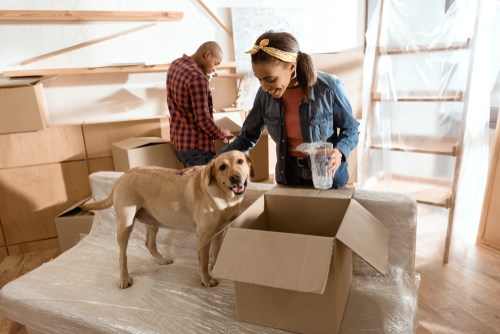
If you’re planning a residential move, you’re probably quite aware of how much preparation the process requires. From packing lists and scheduling move-in dates, to hiring professional movers and crating and wrapping—the list of things to do can seem never-ending.
For pet owners, one of the most important items on the list is organizing their path to your new home. The farther away you’re moving, the harder it can be to set up a plan for them. However, putting it off until the last minute isn’t recommended as there are some things you can do to make the process easier on you, them, and everyone else involved.
Whether your best friend is covered in fur, feathers, or scales, our team at Coleman Hawaii Movers can help you organize a smooth move for you and your pets. In this guide to pet moving, we’ll reveal some of our best tips for handling your pet’s relocation and what you can do to make the process less stressful on you and on them.
Getting Organized for Your Move
If your move has been decided and you’re in the process of getting started planning your relocation, don’t leave your pets off the to-do list. You’ll need to figure out a plan for them as soon as possible, as there are some things you’ll need to make time for before relocation day arrives.
For those planning local moves in Hawaii, moving your pet might mean bringing them along with you in the car—and you won’t require to worry too much about their transfer. For long-distance moves, however, here’s a checklist of things you’ll need to do in the weeks leading up to your relocation:
Visit the Veterinarian: Make a trip to the vet and have your pet’s health checked one last time before you leave. Explain to your veterinarian that you’re moving away and will need to bring copies of your pet’s health records and vaccination logs with you. You might also need a certificate of health for your pet if you’re moving to another country, and medication refills if your pet takes medications.
Ask for Advice on Moving: If you’re moving far away and need to ship your pet on a flight, you may want to ask your vet about options for handling the transfer. Some pets don’t do well on long flights and might be better off sleeping through the trip with a tranquilizer or sedative. Your vet will know how to properly handle the situation and can give you advice (and possibly a prescription) for medications for your animal’s trip. Your vet may also have recommendations to give you for pet moving, such as reputable pet moving companies or airlines they prefer to make sure your pet is safe on their journey.
Determine Your Pet’s Mode of Transportation: There are a few ways to move pets safely during a long-distance move. The first (and perhaps the best) option is to take them with you in your car. This may not be possible for those moving very far away, like cross-country or overseas. In these cases, research pet shipping companies and airline policies for flying pets to other locations.
Get Your Pet Used to Crates: If your pet is going to need to be crated for a long period of time, such as on a flight, it’s obviously a good idea for your pet to feel comfortable inside of one. If your pet has never used a crate before, take the time to introduce your pet to the crate in the weeks leading up to the move. Take a moment every day to crate your pet—at first for ten minutes, and then increasing the time at ten-minute intervals every few days. It might take some time, but your pet will feel a lot better if they’ve been introduced to their crate before the flight than if it’s suddenly packed into one for long hours on the day of the move.
Ask Your Moving Company for Advice: Some professional moving companies will offer specialized moving solutions for moving your pets, or will offer third-party services for pet shipping through another company. Ask your residential movers for advice on moving your animals to see whether they can help you come up with a good plan for their move.
Distract Them with Toys and Treats: Moving can be very confusing for your pets. If you’re stressed, they’re bound to feel stressed as well. Try to distract them by offering them plenty of treats and toys to play with on moving day. If you can, separate them from the hustle and bustle of moving day by securing them in a fenced yard away from the action, in the garage, or a closed room.
Introduce Your Pet to Your New Home
If you’d like to learn more about the services we provide at Coleman Hawaii Movers for local and long-distance moving and storage, don’t hesitate to let us know. As one of the top-rated moving solutions for our customers in Hawaii and around the world, we’ll help you come up with an affordable, efficient, and streamlined plan to make your moving day a breeze—no matter how big your project is, or where you’re going.
For more information, give our residential movers a call today to speak with one of our friendly agents over the phone. Or, if you’d like to receive a free, in-home moving estimate and consultation with a personal moving coordinator, fill out our online form to get started.Subscribe to Coleman Hawaii Movers's Blog












Comments